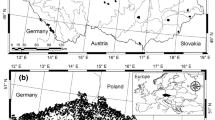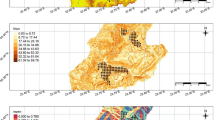Abstract
This paper presents new harmonized distance-independent individual tree basal area growth models for Norway spruce, Douglas-fir and Japanese larch in pure even-aged stands in Southern Belgium. The selected model was originally developed for Norway spruce and Douglas-fir in neighboring France. New formulations are proposed for some of the model components in order to lower the number of fitted parameters and facilitate the fitting procedure. The resulting models integrate the most recent corresponding top-height growth models and use four simple and usually collected explanatory variables: stand age, top-height, total basal area and tree girth at breast height. The modified formulations maintain similar fitting performances and make it easier to interpret the influence of the explanatory variables on tree growth. Parameters estimates were fitted on thousands of growth measurements gathered from several monitoring plots, forest management inventories and silvicultural field experiments that represent the wide range of site conditions and of forest management scenarios applied to coniferous stands in Southern Belgium. Cross-validation of the models revealed no bias and highlighted their consistent behavior over the entire range of girth at breast height, age, top-height, site index and density represented in our dataset. Combining utility and robust performances, these models represent useful forest management tools, purposely ideal for forest simulation software development. Moreover, the flexibility and generic capabilities of the model formulation should make it easily adjustable for other species in even-aged stands.





Similar content being viewed by others
References
Alderweireld M, Burnay F, Pitchugin M, Lecomte H (2015) Inventaire forestier wallon. Résultats 1994-2012. SPW, DGO3, DNF, Direction des Ressources forestières, jambes, 236 pp
Andreassen K, Tomter SM (2003) Basal area growth models for individual trees of Norway spruce, Scots pine, birch and other broadleaves in Norway. For Ecol Manage 180:11–24
Bachofen H, Zingg A (2001) Effectiveness of structure improvement thinning on stand structure in subalpine Norway spruce (Picea abies (L.) Karst.) stands. For Ecol Manage 145:137–149
Bossel H (1991) Modelling forest dynamics: moving from description to explanation. For Ecol Manage 42:129–142
Bruchert F, Becker G, Speck T (2000) The mechanics of Norway spruce (Picea abies (L.) Karst): mechanical properties of standing trees from different thinning regimes. For Ecol Manage 135:45–62
Burkhart H, Tomé M (2012) Modeling forest trees and stands. Springer, Berlin, p 458
Claessens H (2001) Faut-il bannir l’épicéa au nom de la gestion durable? Forêt Wallonne 49–50:36–44
Claessens H, Thibaut A, Rondeux J (1996) Le douglas en Belgique. Gembloux, Faculté universitaire des Sciences agronomiques, Centre de Recherche et de Promotion Forestières, Section Ecologie
Claessens H, Lecomte H, Pauwels D (2002) Le mélèze en Région wallonne: etat des lieux et stations potentielles. Forêt Wallonne 61:4–8
Contreras MA, Affleck D, Chung W (2011) Evaluating tree competition indices as predictors of basal area increment in western Montana forests. For Ecol Manage 262:1939–1949
Courbaud B, Goreaud F, Dreyfus Ph, Bonnet FR (2001) Evaluating thinning strategies using a tree distance dependent growth model: some examples based on the CAPSIS software “uneven-aged spruce forests’’ module. For Ecol Manage 145:15–28
Crahay NI (1900) A propos de quelques résineux de l’Amérique du nord—Le sapin de douglas. Bull Soc Roy For Belg 8:340–351
Dagnelie P, Palm R, Rondeux J, Thill A (1988) Tables de production relatives à l’épicéa commun (Picea abies KARST.). Les presses agronomiques de Gembloux, Gembloux, p 122
Deleuze C, Pain O, Dhote J-F, Herve J-C (2004) A flexible radial increment model for individual trees in pure even-aged stands. Ann For Sci 61:327–335
Dhôte JF (1991) Modélisation de la croissance des peuplements réguliers de hêtre: dynamique des hiérarchies sociales et facteurs de production. Ann des Sci For 48:389–416
Dufour-Kowalski S, Courbaud B, Dreyfus P, Meredieu C, de Coligny F (2012) Capsis: an open software framework and community for forest growth modelling. Ann For Sci 69:221–233
Dyer ME, Burkhardt HE (1987) Compatible crown ratio and crown height models. Can J For Res 17:572–574
Gastine F, Bouvet A, Deleuze C, Monchaux P (2003) Le réseau des essais AFOCEL fête ses 40 ans! Revue Forestière Française 1:47–56
Hasenauer H, Monserud RA (1996) A crown ratio model for Austrian forests. For Ecol Manage 84:49–60
Hébert J, Herman M, Jourez B (2002) Sylviculture et qualité du bois de l’épicéa en région wallonne. ASBL Forêt Wallonne, Belgique, p 157
Johnsen K, Samuelson L, Teskey R, McNulty S, Fox T (2001) Process models as tools in forestry research and management. For Sci 47:2–8
Kohavi R (1995) A study of cross-validation and bootstrap for accuracy estimation and model selection. Proc Fourteenth Int Joint Conf Artif Intell 2:1137–1143
Longchang L, Wenkang H, Guoqing W (1991) Study on the method of constructing variable-density yield table. J Northeast For Univ 2:95–99
Millard A (1949) Le mélèze du Japon. Bull Soc Roy For Belg 56:377–382
Monserud RA, Sterba H (1996) A basal area increment model for individual trees growing in even- and uneven-aged forest stands in Austria. For Ecol Manage 80:57–80
Monty A, Lejeune P, Rondeux J (2007) Individual distance-independent girth increment model for Douglas-fir in southern Belgium. Ecol Model 212:472–479
Opio C, Jacob N, Coopersmith D (2000) Height to diameter ratio as a competition index for young conifer plantations in northern British Columbia, Canada. For Ecol Manage 137:245–252
Pain O (1997) OASIS: le logiciel de sylviculture pratique, de la plantation à la coupe rase. Informations—forêt 552, 6 p
Pauwels D, Lejeune P, Rondeux J (2007) A decision support system to simulate and compare silvicultural scenarios for pure even-aged larch stands. Ann For Sci 64:345–353
Peng C (2000) Understanding the role of forest simulation models in sustainable forest management. Environ Impact Assess Rev 20:481–501
Perin J, De Thier O (2014) H50, estimateur d’indice de productivité. Online tool, version 1.1. http://hdl.handle.net/2268/167733. Accessed on 10 August 2015
Perin J, Hébert J, Brostaux Y, Lejeune P, Claessens H (2013) Modelling top-height growth and site index of Norway spruce. For Ecol Manage 298:62–70
Perin J, De Thier O, Claessens H, Lejeune P, Hébert J (2014) Nouvelles courbes de productivité harmonisées pour le douglas l’épicéa et les mélèzes en Wallonie. Forêt Wallonne 129:26–41
Porté A, Bartelink H (2002) Modelling mixed forest growth: a review for forest management. Ecol Model 150:141–188
Pretzsch H (2009) Forest dynamics, Growth and Yield. Springer, Berlin, p 664
Pretzsch H, Biber P, Ďurský J (2002) The single tree-based stand simulator SILVA: construction, application and evaluation. For Ecol Manage 162:3–21
Pretzsch H, Biber P, Schütze G, Bielak K (2014) Changes of forest stand dynamics in Europe. Facts from long-term observational plots and their relevance for forest ecology and management. For Ecol Manage 316:65–77
R Core Team (2012) R: a language and environment for statistical computing. R Foundation for Statistical Computing, Vienna, Austria. ISBN 3-900051-07-0. http://www.R-project.org/
Rondeux J, Laurent C, Thibaut A (1991) Construction d’une table de production pour le douglas (Pseudotsuga menziesii (Mirb.) Franco) en Belgique. Les cahiers forestiers de Gembloux 3, 23 pp
Schütz J-P, Ammann P, Zingg A (2015) Optimizing the yield of Douglas-fir with an appropriate thinning regime. Eur J Forest Res 134:469–480
Slodicak M, Novak J (2006) Silvicultural measures to increase the mechanical stability of pure secondary Norway spruce stands before conversion. For Ecol Manage 224:252–257
Thibaut A, Rondeux J, Claessens H (1995) Indices et courbes de fertilité pour les peuplements de douglas (Pseudotsuga menziesii (Mirb.) Franco) en Belgique. Les cahiers forestiers de Gembloux 16, 11 pp
Twery M (2004) Modelling in forest management. In: Wainwright J, Mulligan M (eds) Environmental modelling: finding simplicity in complexity. Wiley-Blackwell, Hoboken, pp 291–301
Vacchiano G, Derose RJ, Shaw JD, Svoboda M, Motta R (2013) A density management diagram for Norway spruce in the temperate European montane region. Eur J Forest Res 132:535–549
Valbuena P, Del Peso C, Bravo F (2008) Stand density management diagrams for two mediterranean pine species in Eastern Spain. For Syst 17:97–104
Vanclay JK (1994) Modelling forest growth and yield: applications to mixed tropical forests. CAB International, Wallingford, pp 223–250
Weiskittel A, Hann D, Kershaw J, Vanclay J (2011) Forest growth and yield modeling. Wiley-Blackwell, Hoboken, p 415
Wimberly MC, Bare BB (1996) Distance-dependent and distance-independent models of Douglas-fir and western hemlock basal area growth following silvicultural treatment. For Ecol Manage 89:1–11
Wonn HT, O’Hara KL (2001) Height:diameter ratios and stability relationships for four Northern Rocky Mountain tree species. West J Appl For 16:87–94
Acknowledgements
We appreciate the support provided by the Walloon Region—DGRNE through the “Accord-Cadre/Forest Research” project. We would like to address a special thanks to Ir. Hugues Lecomte from the Permanent Regional Forest Inventory of Wallonia (IPRFW) as well as to Dr. Quentin Ponette and Dr. José Genon of the Earth and Life Institute of the Catholic University of Louvain (UCL—ELIE) who provided some of the data used in this study.
Author information
Authors and Affiliations
Corresponding author
Additional information
Communicated by Aaron R. Weiskittel.
Rights and permissions
About this article
Cite this article
Perin, J., Claessens, H., Lejeune, P. et al. Distance-independent tree basal area growth models for Norway spruce, Douglas-fir and Japanese larch in Southern Belgium. Eur J Forest Res 136, 193–204 (2017). https://doi.org/10.1007/s10342-016-1019-y
Received:
Revised:
Accepted:
Published:
Issue Date:
DOI: https://doi.org/10.1007/s10342-016-1019-y




